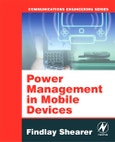Sealed Lead Acid.Nickel Cadmium.Lithium Ion.
How do you balance battery life with performance and cost?
This book shows you how!
Now that "mobile" has become the standard, the consumer not only expects mobility but demands power longevity in wireless devices. As more and more features, computing power, and memory are packed into mobile devices such as iPods, cell phones, and cameras, there is a large and growing gap between what devices can do and the amount of energy engineers can deliver. In fact, the main limiting factor in many portable designs is not hardware or software, but instead how much power can be delivered to the device. This book describes various design approaches to reduce the amount of power a circuit consumes and techniques to effectively manage the available power.
Power Management Advice On:
.Low Power Packaging Techniques
.Power and Clock Gating
.Energy Efficient Compilers
.Various Display Technologies
.Linear vs. Switched Regulators
.Software Techniques and Intelligent Algorithms
Please Note: This is an On Demand product, delivery may take up to 11 working days after payment has been received.








